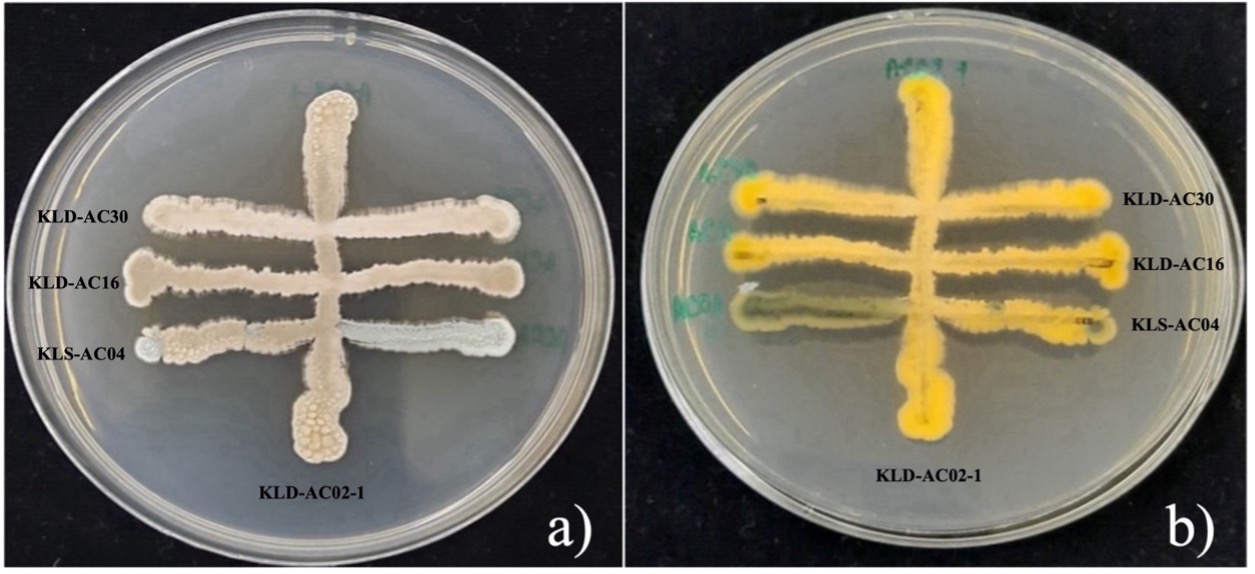Development of a Biofertilizer from Plant Growth Promoting Rhizobacteria Isolated from Millipede Fecal Pellets
DOI:
https://doi.org/10.58837/tnh.24.1.260765Keywords:
Chinese kale, Streptomyces, Thyropygus resimusAbstract
Plant Growth Promoting Rhizobacteria (PGPR) are commonly used to produce biofertilizers. As such, the purpose of the present research was to develop a PGPR biofertilizer formulation from four Streptomyces strains isolated from millipede fecal pellets and to select suitable carriers for them. The four Streptomyces isolates were Streptomyces sp. KLS-AC04, S. zaomyceticus KLD-AC02-1, S. zaomyceticus KLD-AC16 and S. zaomyceticus KLD-AC30. Their compatibility was tested on Actinomycetes isolation agar by the cross-streak method and the results showed that the four isolates can coexist. A viability test was done with three different types of carriers: coconut coir, cow dung and peat moss. The best carrier for all isolates was peat moss (viability: 5.3 x 104 − 8.5 x 105 cfu/g). The isolate that exhibited the highest survival rate across the three carriers was Streptomyces sp. KLS-AC04. Seven PGPR biofertilizer formulations were developed, of which formulation 6 (cow dung: peat moss: KLS-AC04: KLD-AC02-1: KLD-AC16: KLD-AC30) showed the highest viability (6 x 105 cfu/g). The effects of the PGPR biofertilizer formulations on plant growth were explored on Chinese kale. This showed that the use of the four Streptomyces strains had a significant positive effect on germination percentage (range 47.5% − 80.0%), fresh weight (range 0.060 − 0.086 g), shoot length (range 36.1 − 60.4 mm), and root length (range 15.3 − 30.8 mm).
References
Ahamad, L., Shahid, M., Danish, M. 2023. Microbial biofertilizers: an environmentally-friendly approach to sustainable agri-culture. In: Dar, G.H., Bhat, R.A., Mehmood, M.A. (eds) Microbiomes for the management of agricultural sustainability. Springer, Cham.
Alabouvette, C., Olivain, C. and Steinberg, C. 2006. Biological control of plant diseases: The European Situation. European Journal of Plant Pathology, 114: 329–341.
Aloo, B.N., Tripathi, V., Makumba, B.A. and Mbega, E.R. 2022. Plant growth-promoting rhizobacterial biofertilizers for crop production: The past, present, and future. Frontiers in Plant Science, 13: 1002448.
Berg, G. 2009. Plant–microbe interactions promoting plant growth and health: perspectives for controlled use of microorganisms in agriculture. Applied Microbiology and Biotechnology, 84: 11–18.
Chandran, H., Meena, M. and Swapnil, P. 2021. Plant growth-promoting Rhizobacteria as a green alternative for sustainable agriculture. Sustainability, 13: 10986.
Hopkin, S.P. and Read, H.J. 1992. The Biology of Millipedes. 1st ed. Oxford, England: Oxford University Press.
Li, Y., Li, H., Ham, X., Han, G., Xi, J., Lio, Y., Zhang, Y., Xue, Q., Guo, Q. and Lai, H. 2022. Actinobacterial biofertilizer improves the yields of different plants and alters the assembly processes of rhizosphere microbial communities. Applied Soil Ecology, 171: 104345.
Myo, E.M., Ge, B., Ma, J., Cui, H., Liu, B., Shi, L., Jiang, M. and Zhang, K. 2019. Indole-3-acetic acid production by Streptomyces fradiae NKZ-259 and its formulation to enhance plant growth. BMC Microbiology, 19: 155.
Ogbo, F.C., Mavumengwana, V. and Mavumengwana, V. 2018. Plant growth promoting Rhizobacteria as biofertilizers for sustainable agriculture: A review. Agronomy, 8(11): 237.
Olanrewaju, O.S. and Babalola, O.O. 2019. Streptomyces: implications and interactions in plant growth promotion. Applied Microbiology and Biotechnology, 103: 1179–1188.
Purivirojkul, W. and Areechon, N. 2007. Application of Bacillus spp. isolated from the intestine of Black Tiger Shrimp (Penaeus monodon Fabricius) from natural habitat for control pathogenic bacteria in aquaculture. Kasetsart Journal (Natural Science), 41: 125 –132.
Sabaratnam, S. and Traquair, J.A. 2002. Formulation of a Streptomyces biocontrol agent for the suppression of Rhizoctonia damping-off in tomato transplants. Biological Control, 23(3): 245–253.
Sawatphanit, N., Sutthisa, W. and Kumlung, T. 2022. Bioformulation development of Bacillus velezensis strain N1 to control rice bacterial leaf blight. Trends in Sciences, 19(21): 6315.
Smit, A.M. and Van Aarde, R.J. 2001. The influence of millipedes on selected soil elements: A microcosm study on three species occurring on coastal sand dunes. Functional Ecology, 15(1): 51–59.
Subramanian, P., Kim, K., Krishnamoorthy, R. and Mageshwaran, V. 2018. Exploration of beneficial attributes and biofertilizer potential of phosphate solubilizing bacteria in cowpea (Vigna unguiculata L.). Saudi Journal of Biological Sciences, 25(2): 372–377.
Sutthisa W., Paraphong W. and Pimvichai P. 2023. Plant growth-promoting ability and pathogen inhibitory effect of Actinomycetes isolated from fecal pellets of the giant millipede Thyropygus resimus (Diplopoda). Journal of Pure and Applied Microbiology, 17(2): 849–860.
Wang, M., Fu, S., Xu, H., Wang, M. and Shi, L. 2018. Ecological functions of millipedes in the terrestrial ecosystem. Biodiversity Science, 26(10): 1051–1059.
Wang, T., Ahmad, S., Yang, L.,Yan, X., Zhang, Y., Zhang, S., Wang, L. and Luo, Y. 2022. Preparation, biocontrol activity and growth promotion of biofertilizer containing Streptomyces aureoverticillatus HN6. Frontiers in Plant Science, 13:1090689.
https://doi.org/10.3389/fpls.2022.1090689
Wu, S., Zhuang, G. and Bai, Z. 2018. Mitigation of nitrous oxide emissions from acidic soils by Bacillus amyloliquefaciens, a plant growth-promoting bacterium. Global Change Biology, 24: 2352–2365.

Downloads
Published
How to Cite
Issue
Section
Categories
License
Chulalongkorn University. All rights reserved. No part of this publication may be reproduced, translated, stored in a retrieval system, or transmitted in any form or by any means, electronic, mechanical, photocopying, recording or otherwise, without prior written permission of the publisher











